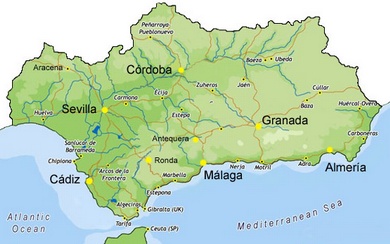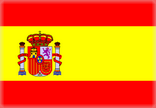

 |




 |
| Sevilla is the provincial capital of Andalucia and has a beautiful historical center. The two major highlights are the Cathedral and the Moorish Alcázar. The cathedral is supposed to be biggest of the world in terms of cubic metres, and harbours the grave of Christoffer Columbus. Most famous, however is the beautiful bell tower, which is a minaret built by the Moors. The Alcázar, a fortification/palace built be the Moors is one of the best examples of Mudejar architecture (a mixture of Moorish and Christian styles). Also the mansion of Pilatus is definately worth a visit. We were lucky enough to be in Sevilla, when the Feria the Abril was being held. It's a yearly festival with lots of dancing, bull fighting and drinking. Especially the Flamenco dresses all the women were wearing were a colorful spectical. Unfortunately, we visited Sevilla when is was raining, so we were'nt able to enjoy the city as much as we hoped for. |

| This city is famous for its Alhambra, the greatest Moorish treasure in Spain and one of the biggest architectural creations in the world. For 7 centuries, this place was It's beautifully located overlooking both Granada and the Sierra Nevada on top of a hill. If you haven't made a reservation for tickets in advance, please make sure you'll be at the ticketoffice at 7 a.m. to get hold of one of the few hundred daily sold tickets (either morning or afternoon shift). You can esaily spend Apart from the Alhambra, the Albaicin ,the old Moorish living quarter, is definately worth a visit: lovely alleys and a spectacular view of the Alhambra with the Sierra Nevada as a backdrop. Again, we had our share of rain in Granada, but luckily during our visit of the Alhambra the clouds gave way for the sun for a change! We didn't visit on of the gypsy caves which is supposed to be good for Flamenco shows, but went to a flamenco restaurant in town instead. |
| This National Park is a must see, if you have any interest in wildlife especially in birds. The most important wetland park of Europe comprises dunes along the coast, enormous marches more inland and on the edges (which is the part you can visit by yourself), there are stands of pine and gallery forest. The park is famous for being one of the last strongholds of the rare Iberian Lynx, as well as a plethora of rare birds inlcuding the Spanish imperial eagle, crested coot, marbled duck and white headed duck to name just a few. Although the rain would have been a niussance in other places it was great to see its effects here: When we visited the park, it had rained the previous days, resulting in the greenest and most flooded marshes in ages, according to our guide. With the help of our very knowlegdable guide José from 'discoveringdoñana', we spotted curlew, spanish imperial eagle, white bellied sandgrouse and many others. It was absolutely great! |
 |
 |
 |

| In the northeastern part of Andalucia lies a rugged mountain range called Sierra de Cazorla. It's particularly well known for its wildlife including Muflon, Ibex, vultures and eagles. Despite the fact that we had to leave one day earl;ier than planned because of rain (again), we still were still able to appreciate the parks natural beauty by means of a fantastic 7 hour walk along the Borosa river. Spectacular gorges, rapids, waterfalls and much wildlife made this walk one of the highlights of our holiday. |
 |

| One of the driest places in Europe is found in Andalucia. The area around Tabernas north of Almería receives the least rainfall in Europe, mainly because most precipitation falls in the adjacant Sierra Nevada. This area boasts some beautiful arid landscapes in which it is great to do some hiking in the many gorges from dry riverbeds that surprisingly enough contain a lot of wildlife. In this area you also have 'mini-Hollywood': a place where many old spaghettiwesterns have been recorded. We didn't visit this, but we did visit a pre-Bronze age fortified settlement, Los Millares, which dates back from around 2500 BC. It's one of the most well preseverved sites from this period and when you're in the area it's worth to take a look. |
 |

| Cordoba was for many centuries (700-1000 AD) the capital of Moorish Spain. Without doubt the pearl of Cordoba is the astonishing Mezquita, the Moorish mosque. It was built and expanded over 3 centuries by different moorish kings. The mosque is famous for its 1293 red and white striped pillars that support the roof of the mosque. It's a fantastic sight. One shouldn't miss the Mihrab, the niche where the Imam was speaking from, as it's one of the most beautiful examples of religious architecture in the Islamic world. Interestingly, when the Christians conquered Cordoba they didn't build a cathedral to replace the mosque, but instead incoporated a small cathredral into the mosque which is totally out of place. So now it's mosque and Cathedral in one. The Jewish Quarter (Juderia) just north of the Mezquita is perfect to explore by foot. In this pittoresque area with white-washed houses and alleys you will find very inviting tea houses & tapas bars. Still nice but less impressive is the palace of the Christian Kings (Alcázar de los Reyes Cristianos). Mainly the gardens west of the palace are very beautiful and well maintained. Also the roman bridge crossing the river dating back from the romans is very nice to see. We also visited Medina Azahara west of Cordoba which is a excavation of a Moorish city and was very interesting. Furthermore we made a daytrip to Parque Natural de Sierra de Hornachuelos where we hoped to encounter black vultures. Unfortunately we didn't... |
 |

| The Rock as it's called is a odd place in every way. It'is essentially nothing more than a big limestone rock linked to the mainland by a small landbridge. Once you've crossed the border where you still have to show your passport, you'll enter a totally different world: An English one. You can eat fish and chips, pay with Pounds and drink pints in pubs. Of course the main draw is the town of Gibraltar, but its rock and its peculiar inhabitants, the Berber Macaques. You can either go up the mountain by car on a very busy road, but a far better and more beautiful way is to take a signed footpath around the southern end of the rock where you will be on your own. You have to be in reasonable shape since you will make your way up from sea level to the top at 450m. With great views and chances of spotting peregrine falcons along the way, this path is highly recommended. Of course there's also the option to take the convenient cable car, but that's a rip off. Despite the fact that is was nice to the monkeys on the rock, it was a pity to see them being fed by tourists and getting aggressive when they didn't get anything. Gibraltar has a long history dating back from the Neanderthals. The best way to appriciate that, is to visit the lovely little Gibraltar Museum, which has expositions on nearly every aspect of gibraltar, from history to stuffed animals. |
© Bart Everts
| Physical activities: eg Walking / Rafting / swimming Nature: eg National Park / Reserve City / Cultural site |
 |

 |
 |
 |
 |
 |
 |


 |
 |
 |

| The Sierra Nevada harbours the highest peak of Western Europe outside the Alps. As a result most of the year you can find snow on the highest slopes, while in the valleys temperatures reach tropical heights. On the southern slopes of this mountain range there are bunch of pittoresque white villages that offer great views and walking upportunities. This area is called the Alpujarras, and was one of the last Moorish strongholds before they were banned from Spain in the 16th century. |

| The town Ronda is famous for its beautiful bridge that crosses the Tajo gorge and that bisects the town. It's definately one of the most dramatically sited towns in Andalucia. Apart from its stunning location, Ronda has the oldest and one of the of most beatiful bull fighting rings of Spain. Around Ronda there is plenty to see and do. First of all, you can find many beautiful 'white towns' in the mountains west of Ronda like Grazalema and Zahara and are worth a visit. The countryside surrounding Ronda offers ample oppurtunities for hiking. Especially, Sierra de Grazalema is great for hiking. It's a park that protects high limestone mountain cliffs and one it's major draw is one of the last stands of the endemic Spanish Fir (kind of conifer) which supports a wealth of birdlife, including many raptors and vultures. Also Spanish Ibex can be found on the higher slopes. |

| Antequera is a small town that's not too interesting. However in the direct surroundings there are a couple of very nice things to visit. Close to town are a couple of reconstructed burial sites dating from the Bronze Age. It's worth a visit if you have the time. If you're interested in birding, the lake of Fuente de Piedra should definately be included in your itinerary. This saline lake, harbour the biggest inland breeding colony of Flamingo's in Europe. Truly a spectacular sight. And lastly, South-west of Antequera lies El Torcal, a limestone landscape of eroded cliffs. It's of great natural beauty. Unfortunately, many schools think the same and on during the day you'll find yourself on the trails competing with loads of schoolchildren. So better come in the early morning or late afternoon, which is also much better for photographing. |











